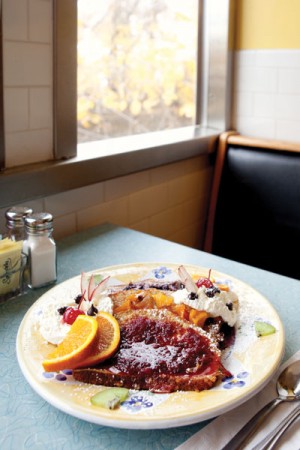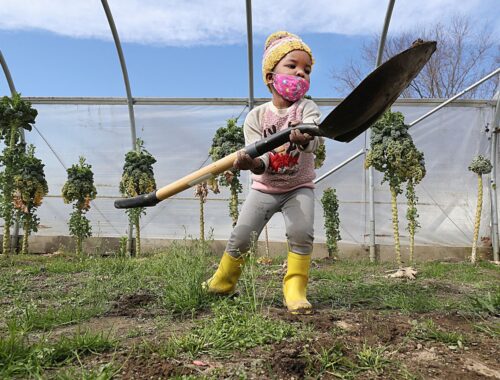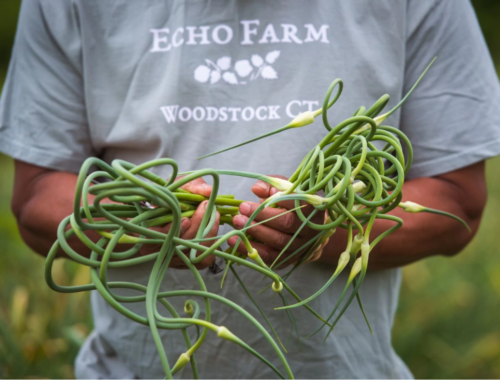
Journey’s End: As America’s first hospice nears its 40th year, the art of comforting the dying continues to evolve.
Originally published in Connecticut Magazine, Vol. 75 No.4, April 2012
As America’s first hospice nears its 40th year, the art of comforting the dying continues to evolve.
Although Gladys’ hair is white, her skin is youthful, her blue eyes clear and direct. Her voice lilts with a gentle Scottish accent.
When I compliment her carnation-pink nails, she quickly folds them into her palms with a laugh of embarrassment and pleasure, explaining, “I was going to hide them because it’s the first time I ever had nails done.” Her new friend and Hospice roommate Irene encouraged her to paint them when a volunteer came to their room offering an array of polishes. “Why not?” Gladys thought. She smiles. “It’s not really me, but I’m getting used to it.”
Gladys was first diagnosed with bladder cancer last year. When it metastasized to her bones four months ago, she decided to stop chemotherapy.
All Hospice patients share rooms and Gladys likes it that way: “When I came in and there were three other ladies in here I thought ,‘We’re all in the same boat here. Whether they snore or they don’t snore…We’re all in the same place.’ So it did not bother me at all. I was glad to see they were also getting the help I was getting.”
Gladys sometimes wakes up during the night and hears nurses at their bedsides. “Sometimes the person being cared for is not even awake,” she says. “They’re changing them or washing them or just gently taking care of them.” She finds this comforting. She tells me about a recent morning when someone new had arrived: “The nurse said, ‘Would you like something to drink?’- You can’t help overhearing- and she mentioned all the different drinks. The lady said, ‘I’ll have ginger ale.’ And the nurse said to her, ‘Would you like it cold or room temperature?’ And I thought, ‘Oh my gosh, another tiny window opens.’”
I ask Gladys what it’s like when one of her roommates dies. “That’s alright because it’s to be expected,” she says. “It could have been me, you know, I could go tomorrow. It was sad, of course, but we didn’t make it sad.”
She describes the woman who died most recently: “she got up one morning and picked up her head and she’s looking at me like this [opens her eyes wide open] and I thought ‘oh my God, am I scaring that woman?’ So then I just waved and she waved. And after that, if I hobbled past her, she’d do the same thing. She’d stare at me like that and then she’d wave again. It was just a connection, you know. But she passed on, too.”
We sit silently, looking at the gray-green water and the small island that lies just off-shore. Gladys says it looks just like the shore where she used to play as a child in Ayrshire, Scotland, near the Isle of Arran. “I see the sunrise come up in the morning and I know what’s going to happen to me,” she says. “But the water calms you. It’s very peaceful— I wouldn’t want to be anywhere else.”
In 1974, Connecticut Hospice in Branford became the first Hospice in the United States, and the model for subsequent ones across the country. Hospice care addresses the physical, spiritual, social and emotional needs of patients with advanced irreversible illness, and their families, all while affirming and enhancing life. Although it is best known for the care it gives to dying patients, the extraordinary caregivers are experts in palliative care, providing pain management and symptom control to patients with cancer, congestive heart failure, cardiac disease, Alzheimer’s disease, HIV/AIDS and other serious and chronic illnesses.
Patients and family are considered one unit of care; within minutes of admission, the nursing and social-work teams jointly assess the needs of both the patient and the patient’s family. Arts and spiritual-care evaluations follow shortly thereafter. Whether in the 52-bed waterfront facility, or through its home-care program, interdisciplinary teams of physicians, nurses, pharmacists, social workers, music and art therapists and spiritual counselors work together to help patients and families in need. Volunteers of every type are also integral to the daily care at Hospice. All of this support, including bereavement groups, is available to family members after a patient dies. And most remarkably, thanks to private donations, care is given to any person in need – regardless of ability to pay.
CEO Rosemary Johnson-Hurzeler has the intensity of someone whose life is consumed by a single purpose. She speaks of every death and admission with urgency— as if it were her first year, rather than her 35th. She is the architect behind many of the inspiring details that pervade the space: imprints of tiny stars in the ceiling tiles for upward facing eyes, and walls that don’t quite reach the ceiling so that sunlight can stream in from every possible source. Every patient room has a view of Long Island Sound and when the weather is warm enough, patient sit in chairs or beds by a walkway that runs along the shore. Rosemary’s tiny dog, Ipsy Pipsy, is her constant companion and works as a pet therapy dog with patients and families. When a young boy died recently, Ipsy played with his young sister on the grassy lawn outside the room while his family grieved.
Rosemary tells me that if I must know one thing about Hospice it is this: “Love Matters.” I felt this love with every Hospice staff member and volunteer I speak to, including Director of Arts Katherine Blossom, Ralph Papp, Director of Social Work and Medical Director Dr. Joseph Andrews. But I most fully and poignantly experienced this love in the interviews I was fortunate enough to conduct with Hospice patients as they faced their final days.
When I arrive at his beachfront house, Dr. Mel Goldstein is at his piano in front of a window facing Long Island Sound.
We sit side by side as he plays “My Funny Valentine.” His vision is blurred and he can’t see the piano keys well; severe neuropathy in his hands means that his fingers can’t feel keys. Despite these challenges, he loves playing: “The Steinway has been for me psychologically a lifesaver…you feel life, emotion, action— you feel love,” he says. “I play for myself and it comes from the heart.”
Although Goldstein was diagnosed with multiple myeloma blood cancer 16 years ago, he remained in pretty good health until “everything fell apart” last summer. A number of bad falls and severe pain in his back, spine and shoulders made him feel that his life was “turning upside down.” He was forced to retire from his work as a weatherman on WTNH. He spent time in the hospital.
When he returned home from the hospital, his wife, Arlene, was terrified of leaving the house for fear he would fall again. She slept only two hours a night. Arlene tells me, “I was overwhelmed…I was so tired.”
After a series of unsuccessful home-care solutions, the Goldsteins found Hospice and their lives were transformed. Not only did their home-care nurse Karen successfully handle his physical care and pain management and match Dr. Mel with his new aid Alvin, she gave his wife indispensable emotional support. Arlene explains, “‘The Can Support Program’ is more help to me than it is to him because I didn’t feel I could manage it myself- I really didn’t. It’s been helpful to him physically, and every time I see Karen come, I am so happy. She brightens up the house.”
The Goldsteins speak of Hospice with reverence. They are grateful that Mel remains in his own home with his piano and his beautiful view, which he calls “invigorating— like a gift you unwrap every single morning.” Each day he and Arlene watch the sunrise together– and each morning Arlene says, “Good morning sunshine; good morning, Mel!”
Susan sits in a wheelchair by a fireplace in a common room looking poised, a colorful silk scarf wrapped around her neck. Her hair is neatly arranged and she wears coral lipstick. Her voice is weak and she chooses her words with care, pausing often to rest.
Her Hospice oncologist, Dr. Anthony Coscia, arrives laughing and making jokes. He calls Susan “the boss,” and they seem like old friends. She’s been at Hospice three weeks.
I ask Susan if she misses being home. She doesn’t speak but her answer is clear. She looks at Dr. Coscia. He puts his hand on hers, then turns to me, “She loves us but she wants out,” he says. “Unfortunately, her care needs are so substantial that it’s not possible for her.”
“I just want to be home,” she says. There is frustration and anger in her voice
She stops and closes her eyes.
Prior to the recent onset of her illness, Susan worked as a salesperson for Marriot. She says, “I miss everything about my independence.”
Bluesman and volunteer Dan Stevens appears at the door smiling and strumming his guitar. Susan lights up and says, “This is my favorite guitarist.” Her request: “Joni.” Dan slowly plays the familiar notes of “Both Sides Now.” Susan listens attentively.
Because it is holiday time, Dan plays Christmas carols. He “barks” a verse of “Jingle Bells”— we laugh and laugh, then sing the rest of the song together as loudly as we can. Susan harmonizes.
When Dan leaves Susan says, “they’ve done a lot for me. They make me feel very special- they make me feel cared for. You should never be afraid to be here.”
She describes the moment she first arrived in her room: “I just broke down. I walked in the room and everybody was like this [she forms her lips into a small gaping circle] ….” Her voice trails off. She exhales heavily.
“It’s scary, but I got over it”
I say “Since you’ve been here, you’ve felt less afraid of being here.”
We look at each other for 10 long seconds.
“Yes,” she says, “because I presume at the end of the day, I’m going to be okay.”
Roberta is at Hospice for a week to stabilize her pain. She beams when she tells me about her “life partner,” John, who is, as we speak, turning their dining room into a bedroom where they can sleep together when she returns home the next day (Hospice calls this “To-ing and Fro-ing” and has helped John make the necessary preparations for Roberta’s return home). John and Roberta met seven years ago working “on the line” at Sikorsky.
Her cancer began with an ankle tumor last spring and has since spread to her uterus, brain, liver and pancreas. She chose to stop her chemotherapy and radiation when it became obvious that it wasn’t working. She is frank when she speaks about her illness. “We know it’s terminal,” she says. “We have all our arrangements made- we went to the funeral parlor and got everything done for that.”
She and John have a home in South Yarmouth on Cape Cod, where they had planned to retire, but she knows that they won’t be able to go there together again. “That was our plan- it just didn’t pan out.”
Roberta loves the water view from her bedroom window at Hospice; it reminds her of the Cape. “At the end I want to come back here,” she says. “I don’t want to die at home because I don’t think it’s fair to do that to him. I want to come back here.”
Jonathan lies perfectly still in his bed. The BIPAP machine attached to his nose in no way masks his soulful dark brown eyes, his smile or his charm. In contrast to his stillness, the room is kinetic with electronics- a television, computer monitor, and speakers. Jonathan was diagnosed with muscular dystrophy at birth. He stopped walking at 11. He is 27 years old.
Music is his life. Using a computer program, he works as a DJ at every opportunity. Days before we speak, Hospice arranged for him to meet the lead singers of his favorite band 2NE1 at an MTV concert in Times Square. Their music and videos play in Jonathan’s room during our visit.
Jonathan dream’s is to work with a ghost writer on a book about his life before he dies. He wants people to see more than his disease. “Some people don’t have a desire to know me or be around me— they just see a wheelchair—they don’t know about the strength that I have,” he says. “They tell me, ‘If I was in here I’d kill myself.’ I can’t think about killing myself— I want to live. I’m just trying to make the best of what I got. I wish it were different. I wish I didn’t have this condition. I wish I could walk around and do everything on my own. I get tired of people taking care of me all the time. I wish I could take care of myself, go out on my own and do my own thing”
Jonathan’s mother, Valerie, devotes her life to her son, even becoming an RN to better care for him. She is intensely warm and very proud of her son. She shows me a scrapbook of newspaper articles about him, and the handwritten text of a speech he gave about her at his high school graduation: “My son’s a deep person and a loving person,” she says. “He’s been a fighter his whole life.”
Last spring, muscular pain and anxiety left Jonathan sleepless. He lost the ability to eat. His doctors recommended a tracheotomy and a feeding tube. They resisted giving him more anti-anxiety medication because of the risk of decreasing his breathing function. Around that time, Valerie went out to see a play. She came home and noticed a few chairs out of place— she then saw disc pads on her son’s chest and he confessed that paramedics had been at the house while she was out. He had suffered a severe and terrifying anxiety attack and called 911. He didn’t want to worry her.
They knew they could no longer manage without Hospice.
Jonathan and Valerie can now speak to a Hospice nurse at any time of the day or night. When he had another bout of anxiety recently, a Hospice team came to their house at midnight. He and his mom no longer fear the risk of pneumonia that comes with winter trips to doctors’ offices. His Hospice doctors and nurses come to him.
His pain and his anxiety are now under control. Valerie says, “The last three nights he’s actually slept.” With the support and understanding of the Hospice team, she and Jonathan are trying to make peace with the future.
The sky is overcast on the morning of my final interview and a slow steady rain falls. It is two days before Christmas and I dread my meeting: A 16-month-old baby and her parents. As I drive toward Bridgeport, the sky becomes lighter, brighter. By the time I arrive, it is blue.
Soozi Flanigan, director of Hospice, waits outside the long line of brick apartments. She flashes a quick mischievous smile when she greets me. She has accompanied me on the visits I have made to patients outside the Branford facility. Like everyone I’ve met who works there, she is passionately devoted to Hospice. She told me once that she had to do what she calls “soul work” before she came to work there.
We walk past the neat yard enclosed by a wire fence and enter a canary-yellow kitchen. Ernest and Anatalia are from St. Lucia—they great me warmly, quietly. Their daughter Anatali has a chromosomal disorder called Trisomy E. At 16 months, she weighs just 14 pounds and has significant physical and developmental delays. Five to 10 percent of children with Trisomy E don’t live beyond one year. It is something of a miracle that she is alive.
Anatalia and Ernest devote themselves to their daughter’s care. Anatalia says, “She’s here with us and I’m going to take care of her as best as I can no matter what. My whole life is devoted to that little baby girl right now. Just go to my work then come home and take care of her—that’s what I do, all the time. I just put the exhaustion behind my back and take care of her.”
Home-care nurse Kim first visited Anatalia when she came home from the hospital after her daughter’s birth. But to Anatalia, “Hospice” meant “death,” she says, she couldn’t face losing her child.
Last summer, as Anatali’s first birthday approached, the doctors told her parents they shouldn’t keep their hopes high for her survival. Anatalia was terrified. “I started to think ‘Now I need to buy a little casket.’ I started to wonder what I was going to do.”
They called Hospice, and beginning in August, Kim started to visit every week: “Anatalia vents about how she feels, her fears, what to expect—or talks about things that are going well,” says Kim. “We talk about how she wants to do normal things—put her baby in a carriage, maybe go to a play group, but the fear of her getting a cold this time of year is scary.”
Kim checks Anatali physically, coordinates social services and communicates with her doctor about her medications and other health issues. Kim says, “Maybe I’m giving to her, but she’s giving to me.”
Ernest comes downstairs cradling his “Princess.” She has a sweet face, and her eyes search my face for a connection. I play peek-a-boo and she smiles. Her father is solemn and thoughtful. He says, “They already told us how to prepare ourselves. It was very hard—we weren’t expecting it was going to be that way.” Anatalia adds, “But it doesn’t mean it’s all death all the time.”
We sit quietly and watch as Anatalia cradles her baby and whisper-sings a soothing made-up song “Sleep Mommy’s baby, sleep my baby….”
I think of the Hospice credo of making the most of life for as long as life lasts. And in that moment there is only life. And love.
Correction: The printed version of this article identified Rosemary Johnson-Hurzeler as "Founder and CEO." This online version, posted January 22, 2017, has been corrected to read “President and CEO Rosemary J. Hurzeler




